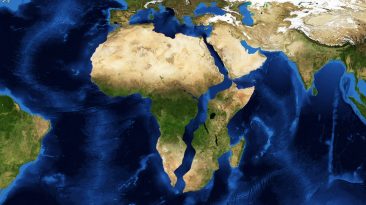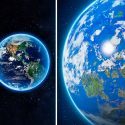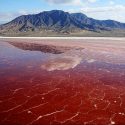The Earth is under attack! And rather than just completely obliterating us, our attackers have decided to simply cut our planet in half. Is this an act of mercy, or the planetary equivalent of a slow and painful death?
Once the cutting begins, the devastating effects would be felt all over the world. Which parts of the globe would be the safest?
How long would life on Earth be able to survive? And what would allow our planet to regenerate itself naturally?
Ripping Earth in half might not mean instantaneous death for everyone on the planet. Instead, some people might be able to survive for a short while if they happened to be in the right place at the right time.
But as the planet rapidly crumbles around them and our social systems fall it wouldn’t be long before mass hysteria sets in. How long would it be before the remaining humans start to turn on each other?
It might start as just a bright light in the sky, something that you could quickly shrug off. But then, as the ground beneath you starts to shake violently, and the light keeps getting brighter, you’d know that something is seriously wrong.
As the Earth is methodically sliced in half, its mantle and core would be exposed to the vacuum of space, causing massive earthquakes that would be felt everywhere on the planet. At this point, the death toll would already be in the millions. You’ve seen the kind of destruction that one powerful earthquake can cause, now imagine a bunch of them taking place at the exact same time.
Those who are the furthest from the split would have the best chance of surviving the longest, at least from the initial earthquakes. Amidst all this chaos, people would be turning to their phones and social media for answers, but there would be none to be found.
Frantic calls and texts would be attempted, but very few, if any, would make it through. At this stage, almost all of the planet’s human inhabitants — 7.5 billion people — would be without electricity. Power grids would fail as power stations sank into the ground. No power, no social media.
With their survival on the line, people would start looking out only for themselves. In larger urban centers, being trampled would become a serious possibility, as everyone scrambled for cover from falling buildings.
Earth could start to split along the tectonic plates on both halves, with a barrage of natural and human-made materials being cast off into space. The slice would have also cut through Earth’s atmosphere, exposing the planet’s surface to the vaccum of space, and resulting in even more natural disasters for anyone lucky enough to survive past the first couple of days.
At this stage, the Earth might try and use gravity to help put a bandage on itself as the two halves begin to get pulled back towards one another. You’d think that this reunion would be good news for any remaining survivors, but things would just get worse.
For a while, you’d be dodging the enormous chunks of matter that would be shooting back and forth between the two halves, and then eventually you’d experience astronomical heat levels as the Earth becomes nothing more than two spinning orbs of molten rock.
So yeah, your chances of survival aren’t looking great. In fact, the whole human race would almost certainly be eliminated by this point. The two rocks we used to call Earth would continue circling each other for hundreds of thousands of years until they’d finally collide to form a new, much smaller Earth.
Over the years it would cool down, microscopic life would appear, and eventually – like hundreds of millions of years later – that life could theoretically evolve into some new version of the human species. Annnd, we’re back!
Maybe one day, the new inheritors of the Earth would find a relic of our civilization that would kickstart their understanding of the history of the planet.
Subscribe to What-If on Youtube or follow the show on Facebook Watch.
Sources
- “Africa Is Splitting In Two – Here Is Why”. 2018. The Conversation. Accessed May 21 2019.
- “Fault Lines: Facts About Cracks in the Earth”. 2018. Live Science. Accessed May 21 2019.
- “What If The Earth Split In Half?”. 2019. Youtube. Accessed May 21 2019.
- “What If The Earth Split In Half?”. 2019. Youtube. Accessed May 21 2019.
- “This Laser Could Rip Apart Empty Space”. Meriame, Berboucha, 2019. forbes.com. Accessed May 21 2019.



























